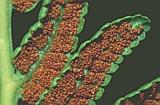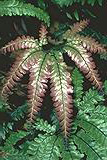|
[Front Page] [Features] [Departments] [SGAP Home Page] [Subscribe]

Introducing Australian Ferns
Lorraine Deppler
|

|
Ferns are an ancient type of plant. They do not flower, but instead reproduce by means of spore. There are over 10,000 species of ferns world wide and the Australian flora consists of more than 400 species.
Ferns may be huge and woody such as the tree ferns - Cyathea, Dicksonia - medium sized, fleshy and clumping such as the Pteris and Blechnum ferns or fine and delicate such as the maiden-hair ferns - Adiantum. There are many more variations in between these examples.
Structure
In the majority of ferns, the above ground part of the plant is nearly always leaves (fronds). The stem (rhizome) may be underground and very small, as in most ground ferns, or it may be large, woody and above ground as in tree ferns. New fronds are tightly coiled and gradually uncoil as they grow. The coiled frond is called a crozier or fiddlehead.
On the under-surface of the fertile fronds are brown or yellow patches which may sometimes be mistaken for disease. These patches may be lines, dots or markings in a specific pattern or they may be found as a continuous line around the margin of the frond. The patches are groups of spore sacs which contain spore. It is these shapes and patterns that may be used to identify different families of ferns.
 |
The spore sacs (or sporangia) on the undersurface of a fertile frond on Todea barbara. Select the thumbnail image or plant name for a higher resolution image (34k). Photo: Fred Johnston
|
Life Cycle
Spore are microscopic dust-like particles which are released from the sporangia (spore sacs) when they are ripe. The spores are dispersed by wind and, if they should settle in a shady, constantly moist and warm position, they may germinate. Germination usually takes about three months but in some species it may take many months. Initially at germination a tiny flat, green heart-shaped structure is formed and it is at this stage that fertilisation occurs. Some weeks later, the first tiny fronds will begin to develop and a new plant will begin to grow.
Habitat
The majority of ferns prefer a cool, moist, shady habitat. In nature these conditions are ideally provided by bushland, rainforests and near streams and waterfalls where the humidity is high.
In cultivation most ferns will grow best where there is protection form hot sun and strong winds and where there is plenty of moisture. Dappled light created by a tree canopy or shrubs is ideal, but these conditions can be reproduced artificially by shadehouses, verandahs, or even the shadowy protection of buildings, fences or boulders. Soil should be able to absorb moisture, but drain well.
If your soil is dry and sandy then digging in lots of compost and peat will help. Ferns appreciate and abundant supply of water, especially over the dry summer months.
Pests and Diseases
Fortunately ferns are not affected by many pests or diseases. Healthy, vigorously growing ferns are able to withstand attacks from pests much more than weak sickly plants. If a fern is constantly affected by pests there may be underlying causes such as poor drainage, overcrowding, lack of air circulation, poor nutrition, lack of water or it may be in a position too exposed to the elements. Fungicidal sprays should only be used as a last resort.
Growing Ferns as House Plants
There are many hardy ferns that will tolerate being grown in pots indoors. The main requirements are adequate light, moisture and humidity. They should not be grown in direct sunlight very close to windows where they can be burnt or can dry out rapidly. On the other hand, pale and spindly growth will result if there is not enough light. A good quality potting mix should be used; one that will drain adequately but still retain sufficient moisture for the plants needs. Lack of humidity caused by heaters drying the air in the house can be a problem to ferns. Humidity may be increased by spraying the fronds daily with water or placing the pots on a tray of pebbles with water in the tray. As the water evaporates it creates humidity around the plants.
|
Some ferns suitable for indoor cultivation are:
- Adiantum hispidulum (rough maidenhair fern)
- Asplenium australasicum (bird's nest fern)
- Asplenium bulbiferum (hen and chicken fern)
- Asplenium nidus (bird's nest fern)
- Dicksonia antarctica (spore-grown plants)
- Pteris umbrosa
- Pteris tremula
Select the thumbnail image or plant name for a higher resolution image (48k).
Photo: Fred Johnston
|

Asplenium australasicum
Bird's nest fern
|
Ferns suitable for cultivation
- Dicksonia antarctica (soft tree fern)
- This is found in moist bushland, particularly fern gullies, from southern Queensland to Tasmania. Sometimes they may develop a massive trunk over 15m tall. The trunk is covered with brown fibrous roots and the upper part is covered with soft brown hairs. This tree fern, commonly seen in gardens and ferneries, is very hardy in cultivation but requires plenty of water to keep it looking good. Propagation from spore takes many years to achieve a trunk, but in the meantime it does make a hardy and attractive looking ground fern or even an indoor pot plant. These tree ferns are often seen for sale in nurseries with large trunks, no roots, and the fronds cut off. These have mostly been harvested from the bush and will grow roots when planted in a moist, shady situation in the garden. If you are buying a fern this way, always check that there is a 'Department of Conservation and Natural Resources' tag attached to ensure it was taken under licence. Dicksonia antarctica is the only tree fern that will tolerate this kind of harvesting.
- Cyathea australis (rough tree fern)
 
- These ferns have been known to grow over 12 metres high. The trunk is large and covered with pointed tubercles which give it the common name of rough tree fern. It is probably the commonest tree fern in eastern Australia. The natural habitat and distribution is much the same as Dicksonia antarctica. It grows well from spore and a well grown plant in a pot could have a reasonable trunk in about 5 years after planting in the ground.
Select the thumbnail image or plant name for a higher resolution image (53k).
Photo: Fred Johnston
- Cyathea cunninghamii (slender tree fern)
- In nature this tree fern may grow to over 20m tall. The trunk remains relatively slender. It is usually only found in moist fern gullies and in cultivation needs plenty of water and protection from the wind and sun
- Cyathea cooperi (scaly tree fern)
- This tree is found growing in Queensland to Southern New South Wales. It is a splendid alternative to Dicksonia antarctica as a garden fern that can be grown from spore, is reasonably fast growing and need not be harvested from natural bushland. It will develop a large trunk in a couple of years after planting out and it tolerates cooler climates quite well.
- Christella dentata (binung)
- A handsome species usually found growing along water courses in forests. It grows into a round spreading tussock of dark green fronds. Very fast growing and suitable for cultivation in a shady garden or fernery.
- Hypolepsis punctata (downy ground fern)
- Large erect light green fronds up to three metres tall in nature, but not usually seen this tall in cultivation. The stipes are covered in soft sticky hairs when young. It is very easy to grow in a damp position but may spread too rapidly. It can be confined to a large tub for some time.
- Lastreopsis acuminata (shiny field fern)
- A handsome lacy-looking fern with dark green fronds. It is easily grown in a pot and also suitable for growing in the ground.
- Adiantum hispidulum (rough maidenhair)
 
A tough fern with shining black stipes (stems) and large delicate-looking fronds. The new fronds are an attractive pink or bronze colour gradually changing to green as they mature. This is a hardy species which also makes an excellent indoor pot plant.
Select the thumbnail image or plant name for a higher resolution image (42k).
Photo: Fred Johnston
- Adiantum aethiopicum (maidenhair)
- A dainty-looking fern which grows vigorously with a suckering habit. It quickly outgrows pots and is best planted in the ground in a moist, protected area. It tolerates some sun as long as it has plenty of water.
- Asplenium bulbiferum (hen and chicken fern)
- These ferns usually produce an abundance of plantlets on the pinnae (leaflets). The plantlets grow slowly, and when large enough can be removed and allowed to root into a moist potting mix.
- Pteris tremula (tender brake)
- A fast growing species with attractive upright pale green fronds and a fine lacy appearance.
For further reading
- Duncan, Betty D and Isaac, Golda; Ferns and Allied plants of Victoria, Tasmania and South Australia.
- Jones, D.L. and Clemesha, S.C; Australian Ferns and Fern Allies.
- Jones, D.L; Encyclopedia of Ferns.
From the March 1997 issue of the Newsletter of the Victorian Region of SGAP..

[Front Page] [Features] [Departments] [SGAP Home Page] [Subscribe]
Australian Plants online - March 1998
The Society for Growing Australian Plants
|